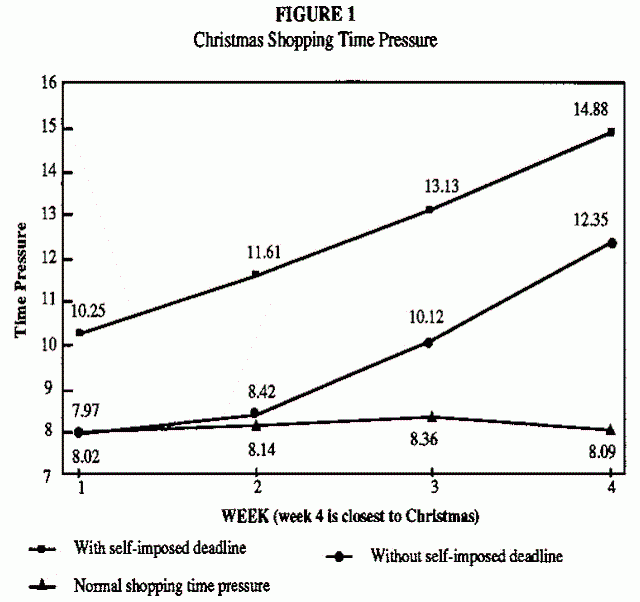Why We Spend: 5 Ways Rational Christmas Shopping Is An Oxymoron

The mayhem of Black Friday is eclipsed only by the ensuing weeks of holiday madness, when kids strung out on egg nog and parents wired on holiday blend coffees populate the local malls. They scramble, often under strict deadline, to find the season’s hottest toy and avoid yet another year of knock-off-brand disappointment.
With all this commotion swirling around our heads, it’s a wonder we survive until New Year's Eve. We have so much riding on not ruining Christmas that we end up succumbing to countless acts of irrationality. Here are five ways rational Christmas shopping is a total oxymoron:
5. The Bandwagon Effect
Marketers love the bandwagon effect. It’s practically how they make their living. Whether it’s consumer electronics or the year’s popular stuffed animal, the whole point of a fad is to reassure people that a sense of normalcy can be found in keeping up with the Joneses.
Consider the bandwagon effect in a popular psychology study from 1951, called The Asch Conformity Experiments. A row of subjects was shown two pictures, the first a single line and the other a collection of three lines, marked A, B, and C. They were asked to report which of the three matched the first line. The trick was, all of the subjects were actors except one person. When no social pressure was applied, subjects answered incorrectly less than one percent of the time — the answer was a no-brainer. But when the actors all gave the (clearly) incorrect answer, 32 percent of respondents jumped on the bandwagon and agreed with them.
Researcher Solomon Asch concluded that when people are confronted with a group of opinions they wouldn’t normally hold, the added pressure compels people to drop their beliefs in favor of the group’s. On its own, the bandwagon effect is actually fairly flimsy. Asch found introducing just one partner to agree with the subject reduced the error rate to nearly five percent. But taken together with other cognitive biases, the bandwagon effect can lead people down risky, even dangerous, roads.
4. The Ostrich Problem
So what happens when we whet our beaks and begin wanting what everyone else has? According to a recent study from the University of Sheffield, we bury our heads in the sand and vow not to look at our bank statements until the holiday shopping storm has passed.
Dubbed the “Ostrich Problem” (after the birds’ tendency to go bobbing for sand, temporarily blinding them), the researchers point out that the Christmas season can make for a frustrating reminder that we’re on a budget. Sure, we may have beloved out-of-town relatives whom we’d like to shower with gifts (and some we’d happily never see again), but one day a year hardly seems like a responsible justification to over-indulge, especially when self-gifting rears its ugly, discounted head.
"There will be plenty of us over the Christmas period who will not check our bank balance or look at the calories on the back of the box of mince pies despite us wanting to be in control of our money or lose weight," said Dr. Thomas Webb, of the University’s Department of Psychology, in a statement. “Avoiding monitoring may allow people to escape from negative feelings associated with an accurate appraisal of progress.”
The holidays are meant to be a time of joy, after all. Who would want to confront the woes of declining funds or impending credit card bill? The Ostrich Problem reflects our compulsion to keep Christmas a treasured vacation, a break from our daily struggle to bring home the bacon. So we fool ourselves, repeating the mantra that if we can’t see the problem, then it must not exist.
3. Ingroup Bias (aka the New Toy Dilemma)
Where do these blindly allocated funds go? They’re sunk into the products peddled on the bandwagon, of course. Unfortunately, businesses have become particularly crafty when it comes to ensuring there’s a demand for their product. So months ahead of time they set a release date sometime around Christmas, when people are primed to spend and ready to bust out the plastic and drop hundreds of dollars on items that will get banished from playtime by next March. In short, we all know how crazy shoppers can be.
Social scientists refer to mechanism behind this craziness as the ingroup bias, because what is a horde of violent parents, beating each other senseless with purses and leather driving gloves, than a group of people that think their kid deserves the best? The ingroup bias reflects our natural tendency to look favorably upon members of our social circle and, indeed, negatively toward outsiders.
While this may seem perfectly rational, given its primitive roots, the ingroup bias prevents us from acting according to society’s best interests. In more serious examples, it’s what kept racism so institutionally entrenched for centuries. It’s the fear and emotion that motivates behavior, not thinking and empathy. The rabid mothers cursing each other out, just so they can get their hands on the last TV, aren’t stopping to consider one another’s situation. Maybe one child has a terminal illness and wants to watch his favorite cartoons for the last time. Maybe the other just got home from painful corrective eye surgery.
In real-time these conversations aren’t possible, of course. No one should be expected to detail their life story in the middle of a crowded Wal-Mart. But it should serve as a reminder of how emotional Christmas shopping is at times. Practical gifts have their place — who doesn’t need more socks? — but as critics of the gift card economy can attest, the best gifts come from the heart. Even if that means ripping out someone else’s to get them.
2. Current Moment Bias
So you’ve wrestled elderly women to the ground, all to snag the last Blu-ray of One Direction: This Is Us, and now you’re out of harm’s way. Still riding out the high of consumer success, you notice four more movies your family (or your personal collection — see “self-gifting”) would love. In the end, you spend more on the gifts you didn’t intend to buy than ones you walked in for. What happened?
Ask psychologists and they’ll tell you that you fell victim to the Current Moment bias. Ask a group of marketers and they’ll check the win column for the infamous impulse buy. The phenomenon has been around for decades, used as a surefire tactic to encourage spending. One 1993 study, published in the journal Advances In Consumer Research, showed that the closer people get to their shopping deadlines, the more likely they are to purchase items on-the-fly.

As the researchers’ data shows, it’s in consumers’ best interest to complete holiday shopping as early as possible, in order to minimize their sensation of felt time pressure. Of course, if you wait until the last second and need to find a way to make yourself feel better, there’s always…
1. Post-Spending Rationalization
As a principle of economics, loss aversion relies on the theory that people gain much more unhappiness from loss than happiness from an equal gain. In other words, you’d become much sadder if you lost $5 than happier if you had found $5. The behavioral economists Amos Tversky and Daniel Kahneman have pegged losses as twice as powerful as gains. So what happens when we buy an industrial-strength blender even though we already have a perfectly fine, somewhat older model waiting at home? We rationalize.
We tell ourselves that the handle was crooked, and that it’s always bugged us. We point to the cord, with its barely frayed end. We could electrocute ourselves, we say to our spouse. (This blender would never do that.) And so, we replace the working blender with its beefed up cousin and toss the old one in the garbage, refusing to take the new one back to the store and return it even if that’s the smart thing to do.
Depending on how we came to learn about this blender, the entire sequence of events leading up to its installation may be a result of numerous acts of irrational decision making: The bandwagon effect persuading us to buy, the Ostrich Problem taking our finances out of the picture, the Ingroup bias further cementing our desire to own it, and the post-spending rationalization convincing us it’ll look great next to the fridge.
So before you open your wallet this holiday season, instinctually reaching for your credit card, ask yourself: Would I do this on Dec. 26? If not, you may want to keep the frayed cord and crooked handle, at least for one more year.



























